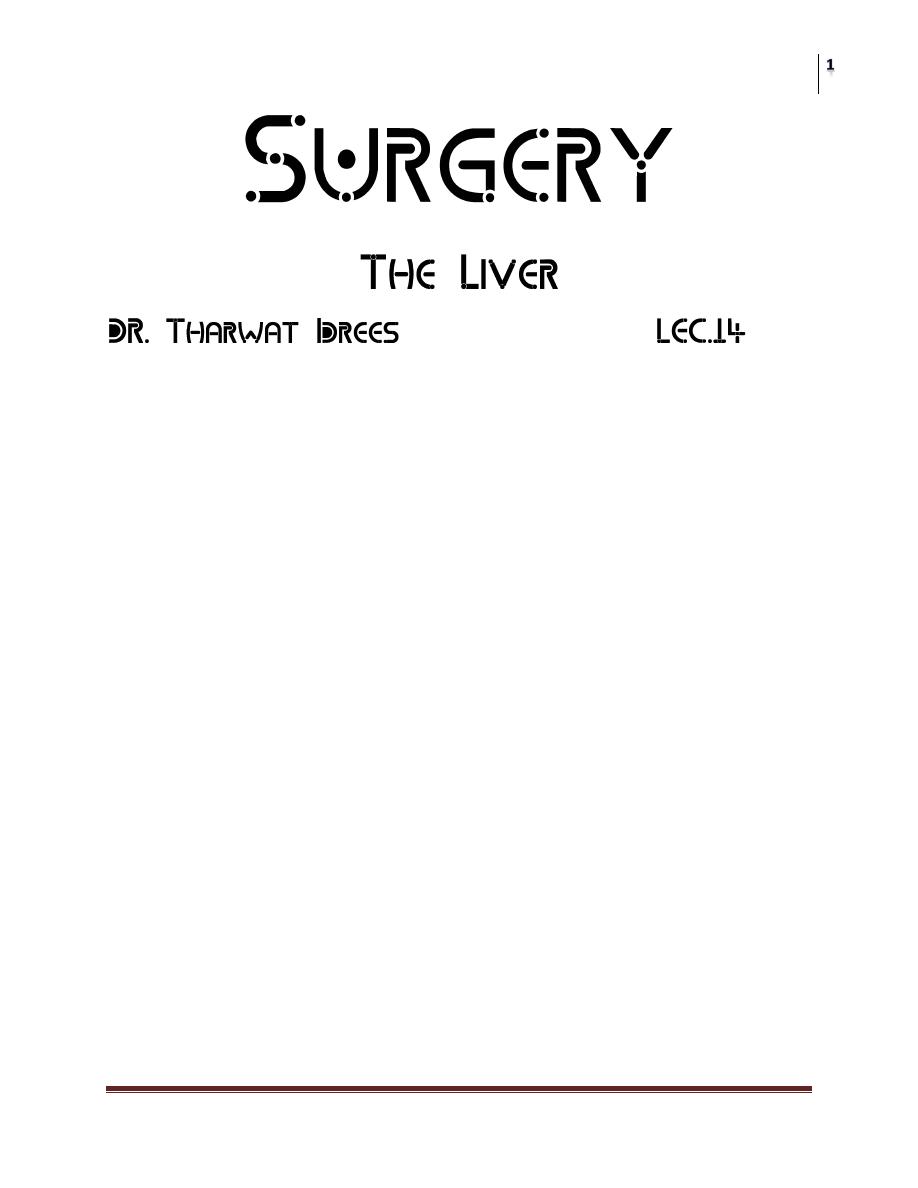
Surgery
The Liver
Dr. Tharwat Idrees
Lec. 14
Anatomy:
It is composed of two lobes (Rt. and lt.) and each lobe is further divided into
segments (8 segments). Functional Rt. lobe is composed of (segment V-VIII) while
functional Lt. Lobe is composed of segments I- IV). The liver is fixed in place by
two ligaments, the Falciform ligaments and Teres ligament. The lesser omentum is
a peritoneal reflection between the stomach and the liver.
80% of liver blood supply is from the portal vein and 20% from the hepatic artery
(from celiac trunk). The RT hepatic artery supplies the majority of liver
parenchyma. Within the hilum of the liver, the portal vein, hepatic artery and bile
duct are present within the free edge of the lesser omentum or the hepatoduodenal
ligament ( the bile duct is within the free edge , the hepatic artery above and medial
and the portal vein lies posterior).
Venous drainage of the liver is via three large hepatic veins into the IVC
immediately below the diaphragm.
Functions of the liver:
1. Maintaining core body tempts.
2. PH balance and correction of lactic acidosis.
3. Synthesis of clotting factors.
4. Glucose metabolism
5. Urea formation from protein catabolism.
6. Bilirubin formation
7. Drug and hormone metabolism
8. Removal of gut endotoxins and foreign antigens

Surgery
The Liver
Dr. Tharwat Idrees
Lec. 14
Liver function tests:
Bilirubin
5-17 micromol/L
Conjugated
< 5 micromol/l
And non-conjugated
Alkaline phosphatase (ALP) 5-130 iu/L
Aspartate transaminase (AST) 5-40 iu/L
Alanine transaminase (ALT) 5-40 iu/L
Gamma-glutamyl transpeptidase(GGT) 10-48iu/L
Albumen
35-50G/L
Prothrombin time (PT)
12-16 seconds
Acute liver failure:
Etiology:
1. viral hepatitis
2. drug reactions (halothane, NSAIDs, antidepressants)
3. paracetamol overdose
4. mushroom poison
5. shock and multiorgan failure
6. acute Budd-Chiari syndrome
7. Wilsons disease
8. fatty liver of pregnancy
Clinical features:
In the early stages there are no objective signs but in severe conditions there will
be jaundice and neurological signs of liver failure (liver flap, drowsiness,
confusion and coma)
Supportive therapy for acute liver failure:
1. fluid and electrolytes balance
2. acid base balance and glucose monitoring
3. nutrition support
4. renal function (dialysis)
5. respiratory support(ventilation)
6. monitoring and treatment of cerebral oedema
7. treatment of bacterial and fungal infections

Surgery
The Liver
Dr. Tharwat Idrees
Lec. 14
Features of chronic liver disease
Lethargy, fever, jaundice, wasting, coagulopathy, hyper dynamic circulation,
hepatic encephalopathy, portal hypertension, ascites, esophageal varices,
splenomegaly, spider nevi, and palmer erythema.
Imaging of the liver
1. Ultrasound (US):
First line, safe and available
Operator dependant
Can detect gallstones, bile duct dilatation, and tumors of the liver
2. Spiral computerized tomography (CT)
It is useful for detection of small (early) liver lesions and gives a good idea about
its nature and vascularity. In addition it can differentiate between inflammatory
lesions of the liver and haemangiomas. It can measure the density of liver lesions
which can be useful in cystic lesions.
3. Magnetic resonance imaging (MRI)
As effective as spiral CT but it has several advantages as it doesn’t require
contrast media to visualize the liver and biliary tree (MRCP). It is useful in
imaging of portal vein or hepatic arteries without the need for arterial
cannulation
4. Endoscopic retrograde cholangiopancreatography (ERCP)
5. Percutaneous transhepatic cholangiopancreatogrphy (PTC)
6. Angiography
7. Nuclear medicine scanning
8. Laparoscopy and laparoscopic ultrasound
9. Fluorodeoxyglucose positron emission tomography(FDG-PET)
Liver trauma:
Uncommon, serious and associated with significant morbidity and mortality.
1. Blunt traumatic injuries: contusion, laceration, and avulsion injuries.
2. Penetrating injuries: stab wound and gunshot wound

Surgery
The Liver
Dr. Tharwat Idrees
Lec. 14
Diagnosis:
1. Clinical suspicion: all upper abdominal and lower chest stab wounds or
severe crushing injury should be considered seriously as a possibility of liver
injury.
2. Clinical findings: signs of external trauma, signs of hemodynamic instability
(hypotension or shock, tachycardia, pale clammy skin etc.
3. Ultrasound of the abdomen: may show free fluid in the abdomen or
laceration of the liver
4. Oral and intravenous enhanced CT scan of the abdomen and chest. It will
show parenchymal damage of the liver and other associated organs like the
spleen or lungs as well as their vessels
5. Peritoneal lavage; to confirm hemoperitoneum
6. Laparoscopy
Management of liver injuries:
1. Penetrating injuries:
Resuscitation:
Initial survey (ABCDE),
IV large bore cannulas
Blood sample for full investigations
IV fluids and blood (fresh)
Surgery for all injuries
2. Blunt trauma :
Resuscitation
Surgery or conservative management
Complications of liver injuries:
1. Subcapsular hematoms ; conservative treatment
2. Liver abscess ; aspiration under us guide and antibiotics
3. Bile collection ; aspiration under us guide
4. Biliary fistula ; biliary decompression by nasobiliary or percutaneous
drainage or endoprosthesis or resection of liver segment
5. Hepatic artery aneurysm
6. Arteriovenous fistula
7. Arteriobiliary fistla
8. Liver failure : in severe complicated injuries

Surgery
The Liver
Dr. Tharwat Idrees
Lec. 14
Chronic liver diseases
1. Budd-chiari syndrome
2. Primary sclerosing cholangitis
3. Primary biliary cirrhosis
4. Carolis disease
5. Simple cystic disease
6. Polycystic liver disease
Liver infections
1. Viral hepatitis
a. Hepatitis A:
Infective hepatitis, self-limiting, supportive treatment.
b. Hepatitis B:
Produce more serious damage with the development of liver cirrhosis and
primary liver cancer. It may present as acute hepatitis or at a later stage due to
the complications of cirrhosis, mostly ascites or variceal bleeding.
Treatment of acute hepatitis is supportive.
Treatment of chronic form depends on the type of complications. In established
end stage cirrhosis antiviral therapy to eradicate the virus followed by liver
transplantation.
c. Hepatitis C:
It has become one of the most common causes of chronic liver diseases.
Usually transmitted by blood transfusion. Clinical presentation and
complications are similar to hepatitis B, and the treatment is also similar.
2. Ascending cholangitis :
Bacterial infection of biliary tree usually due to obstruction of biliary tree.
Presentation: jaundice, rigor and tender hepatomegally.
Diagnosis: Ultrasound shows dilated bile ducts, obstructive picture of liver
function tests , and isolation of pathogeneic bacteria from blood on culture .

Surgery
The Liver
Dr. Tharwat Idrees
Lec. 14
Treatment: antibiotics (3rd generation cephalosporin), IV fluid for rehydration,
endoscopic or percutaneous drainage of biliary tree and removal of stones
(usually present)
3. Pyogenic liver abscess:
Common in old age patients, diabetics and those on immunosuppressive.
Presentation: fever, anorexia, malaise and RT upper quadrant discomfort.
Diagnosis: US or CT that showed multiloccular cystic mass. This is confirmed
by aspiration and culture of the aspirate (commonly streptococcus milleri and E.
coli) or less commonly other enteric organisms.
Treatment: penicillin, aminoglycosides and metronidazole, or cephalosporins
and metronidazole.
Percutaneous drainage under ultrasound guide
4. Amoebic liver abscess:
Reach the liver from the colon via portal circulation. The abscess is diagnosed
by aspiration and treated by metronidazole.
5. Hydatid disease of the liver :
Common in Iraq and Mediterranean countries. Caused by Ecchinococcus
granulosus. Ova are ingested by human and reach the liver through portal
blood.
Usually asymptomatic until it reach a large size when it might cause slight RT
upper abdominal discomfort.
Diagnosis: Multiloculated cyst by ultrasound supported by the finding of a
floating membrane within the cyst on CT scan.
Rapture of the cyst might lead to dissemination of large number of daughter
cysts into the peritoneal cavity. Liver cysts can also rupture through the
diaphragm, producing empyema, into the biliary tree producing obstructive
jaundice or into the stomach. Serology by ELISA test for Abs is comfirmatory
to the diagnosis.
Treatment: Medical treatment by albendazole or mebendazole should be tried
first.

Surgery
The Liver
Dr. Tharwat Idrees
Lec. 14
Failure of medical treatment usually require surgical intervention (liver
resection or local excision of the cyst with deroofing . biliary communication
should be sutured
Liver tumors
I. Benign liver tumors
1. Haemangioma:
Most common benign tumor with increasing reporting. Abnormal plexus of
vessels. Diagnosis by US and CT with delayed contrast enhancement (slow
contrast enhancement). Often multiple and require no treatment unless it is giant
and symptomatic.
2. Hepatic adenoma:
Rare tumors. Has malignant potential. More common in females receiving
contraceptive pills. Diagnosed by CT(well circumscribed and vascular tumor), but
it is difficult to be differentiated from malignant tumors by radiology only so
diagnosis is confirmed by percutaneous biopsy or surgical resection of the tumor
with histological confirmation . Treatment is surgical excision.
3. Focal nodular hyperplasia:
Unusual tumor of unknown etiology occurs in middle aged females.
US show a solid tumor. CT scan shows central scarring and well vascularized
lesion. Sulphur colloid scan may differentiate FNH from adenoma or metastatic
carcinoma.
II. Malignant liver tumors:
1. Hepatocellular carcinoma:
One of the most common cancers and its incidence is increasing due to the
association with chronic liver diseases (HBV and HCV).
Symptoms are either of chronic liver disease (malaise, jaundiced, ascites, variceal
bleeding, encephalopathy) or with symptoms of advanced cancer (anorexia and
weight loss).

Surgery
The Liver
Dr. Tharwat Idrees
Lec. 14
Treatment : either resection of the tumor or liver transplantation depending on the
age of underlying liver disease , the size and site of the tumor , and the availability
of organ transplantation .
There is little evidence that chemotherapy will improve the prognosis and it may
damage the remaining liver tissue.
AFP and imaging are used for follow up
2. Cholangiocarcinoma:
Typically presented with painless obstructive jaundice.
Slowly growing tumors. Usually at confluence of Rt and Lt hepatic ducts
producing fibrotic lesion with tight duct stricture.
Lesions in the distal bile ducts are usually polypoidal causing obstruction with
lymphatic metastasis.
Diagnosis by US which shows dilated intrahepatic bile ducts.
MRI with MRCP will confirm the diagnosis and determine the extent of the tumor.
ERCP and brush cytology will provide tissue diagnosis.
Treatment: surgical resection offers the only possibility of cure and the best form
of palliation. Radical resection of the liver paracnchyma associated with the
affected bile duct is the best treatment.
3. Carcinoma of gall bladder:
Unknown etiology but usually associated with gall stones .
It may be diagnosed incidentally after cholecystectomy for gallstones or the patient
may present with pain or obstructive jaundice (advanced tumors).
In those with incidental tumor limited to the mucosa of gall bladder the prognosis
is good while those with transmural involvement or obstructive jaundice the
prognosis is poor.
Radical excision offers the only hope for cure. Chemotherapy is of no benefit.
In advanced irresectable disease relieve of symptoms can be achieved by biliary
endoprosthesis.
